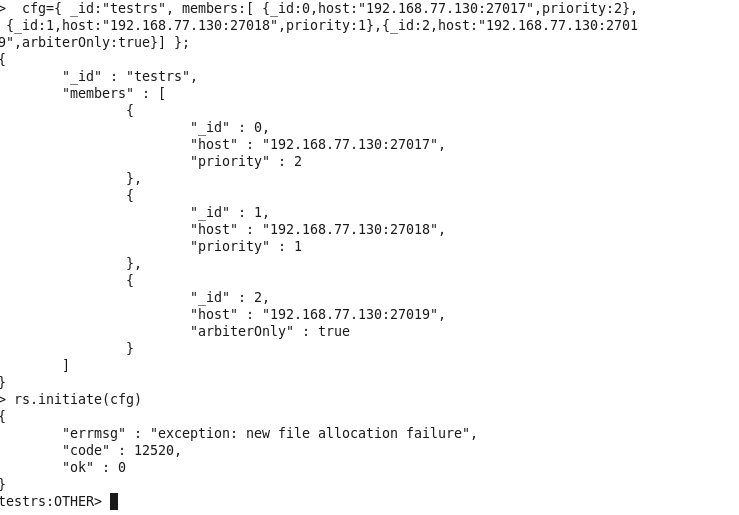在MongoDB所在路径创建log和data目录
mkdir log
mkdir data
在data目录下 创建master、slaver、arbiter路径
mkdir master
mkdir slaver
mkdir arbiter
新建日志文件
在log下执行 touch mongodb.log 创建log文件
在MongoDB根目录下创建master.pid slaver.pid arbiter.conf.pid (用来记录启动的进程号)
daemon方式启动的fork参数也可以配置配置文件中 在bin下创建master.conf slaver.conf arbiter.conf文件:配置如下 (主,备,仲裁节点)
创建master.conf
#master.conf
dbpath=/usr/local/mongodb-linux-x86_64-3.0.6/data/master
logpath=/usr/local/mongodb-linux-x86_64-3.0.6/log/master.log
pidfilepath=/usr/local/mongodb-linux-x86_64-3.0.6/log/master.pid
directoryperdb=true
logappend=true
replSet=testrs
bind_ip=192.168.77.130
port=27017
oplogSize=10000
fork=true
noprealloc=true
创建
slaver.conf
dbpath=/usr/local/mongodb-linux-x86_64-3.0.6/data/slaver
logpath=/usr/local/mongodb-linux-x86_64-3.0.6/log/slaver.log
pidfilepath=/usr/local/mongodb-linux-x86_64-3.0.6/log/slaver.pid
directoryperdb=true
logappend=true
replSet=testrs
bind_ip=192.168.77.130
port=27018
oplogSize=10000
fork=true
noprealloc=true
创建
#arbiter.conf
dbpath=/usr/local/mongodb-linux-x86_64-3.0.6/data/arbiter
logpath=/usr/local/mongodb-linux-x86_64-3.0.6/log/arbiter.log
pidfilepath=/usr/local/mongodb-linux-x86_64-3.0.6/arbiter.pid
directoryperdb=true
logappend=true
replSet=testrs
bind_ip=192.168.77.130
port=27019
oplogSize=10000
fork=true
noprealloc=true
主从节点启动
./mongod -f master.conf
./mongod -f slaver.conf
./mongod -f arbiter.conf
连接相应节点
./mongo 10.1.235.62:27017
./mongo 10.1.235.61:27018
......
参数含义:
dbpath:数据存放的目录
logpath:日志存放路径
pidfilepath:用于记录进程号的文件
logappend: 记录日志
relSet:replica set的名字
bind_ip:mongodb的ip地址
port:端口号
oplogSize:mongodb操作日志文件的最大大小
noprealloc:不预先分配存储
启动客户端连接
./mongodb
退出
在shell中输入exit
相关命令:
show dbs; show collections; show users; show profile; show logs
如果想创建一个数据库名称 <coc>
use mydb
要检查当前选择的数据库使用命令:
db
创建的数据库mydb 列表中是不存在的。要显示的数据库,需要把它插入至少一个文件。
db.movie.insert({"name":"tutorials yiibai"})
配置主、从、仲裁节点:
首先连接一个mongdb地址
./mongo 192.168.77.130:27017
执行初始化配置,这里的priority的值越高,初始化完后,该节点就会成为主节点,arbiterOnly:true 代表该节点为仲裁节点。
cfg={ _id:"testrs", members:[ {_id:0,host:"192.168.77.130:27017",priority:2}, {_id:1,host:"192.168.77.130:27018",priority:1},{_id:2,host:"192.168.77.130:27019",arbiterOnly:true}] };
执行初始化
rs.initiate(cfg)
通过rs.status()查看状态。 这里在自己的机子上初始化可能会报 这个该死的问题折磨死我了,最后发现是磁盘空间不足导致的。所以在自己的机子上做集群可能会无法初始化

具体还在想办法。。。反正原因大概是这个原因~
如果你不想用这种模式,毕竟有时候虚拟机磁盘会不够初始化,可以就搭个单节点自己玩,那么要删除master.conf文件中的replSet=testrs
然后重启
./mongod -f master.conf
随后连接自己~
./mongo 192.168.77.129:27017

OK了~自己玩吧~
停止mongodb时 千万不要Kill -9 否则会比较麻烦~ 用kill -15就可以啦~
MongoDB与传统SQL:
db.users.find() select * from users
db.users.find({"age" : 27}) select * from users where age = 27
db.users.find({"username" : "joe", "age" : 27}) select * from users where "username" = "joe" and age = 27
db.users.find({}, {"username" : 1, "email" : 1}) select username, email from users
db.users.find({}, {"username" : 1, "_id" : 0}) // no case // 即时加上了列筛选,_id也会返回;必须显式的阻止_id返回
db.users.find({"age" : {"$gte" : 18, "$lte" : 30}}) select * from users where age >=18 and age <= 30 // $lt(<) $lte(<=) $gt(>) $gte(>=)
db.users.find({"username" : {"$ne" : "joe"}}) select * from users where username <> "joe"
db.users.find({"ticket_no" : {"$in" : [725, 542, 390]}}) select * from users where ticket_no in (725, 542, 390)
db.users.find({"ticket_no" : {"$nin" : [725, 542, 390]}}) select * from users where ticket_no not in (725, 542, 390)
db.users.find({"$or" : [{"ticket_no" : 725}, {"winner" : true}]}) select * form users where ticket_no = 725 or winner = true
db.users.find({"id_num" : {"$mod" : [5, 1]}}) select * from users where (id_num mod 5) = 1
db.users.find({"$not": {"age" : 27}}) select * from users where not (age = 27)
db.users.find({"username" : {"$in" : [null], "$exists" : true}}) select * from users where username is null // 如果直接通过find({"username" : null})进行查询,那么连带"没有username"的纪录一并筛选出来
db.users.find({"name" : /joey?/i}) // 正则查询,value是符合PCRE的表达式
db.food.find({fruit : {$all : ["apple", "banana"]}}) // 对数组的查询, 字段fruit中,既包含"apple",又包含"banana"的纪录
db.food.find({"fruit.2" : "peach"}) // 对数组的查询, 字段fruit中,第3个(从0开始)元素是peach的纪录
db.food.find({"fruit" : {"$size" : 3}}) // 对数组的查询, 查询数组元素个数是3的记录,$size前面无法和其他的操作符复合使用
db.users.findOne(criteria, {"comments" : {"$slice" : 10}}) // 对数组的查询,只返回数组comments中的前十条,还可以{"$slice" : -10}, {"$slice" : [23, 10]}; 分别返回最后10条,和中间10条
db.people.find({"name.first" : "Joe", "name.last" : "Schmoe"}) // 嵌套查询
db.blog.find({"comments" : {"$elemMatch" : {"author" : "joe", "score" : {"$gte" : 5}}}}) // 嵌套查询,仅当嵌套的元素是数组时使用,
db.foo.find({"$where" : "this.x + this.y == 10"}) // 复杂的查询,$where当然是非常方便的,但效率低下。对于复杂查询,考虑的顺序应当是 正则 -> MapReduce -> $where
db.foo.find({"$where" : "function() { return this.x + this.y == 10; }"}) // $where可以支持javascript函数作为查询条件
db.foo.find().sort({"x" : 1}).limit(1).skip(10); // 返回第(10, 11]条,按"x"进行排序; 三个limit的顺序是任意的,应该尽量避免skip中使用large-number、
https://www.cnblogs.com/yangsy0915/p/4867310.html
